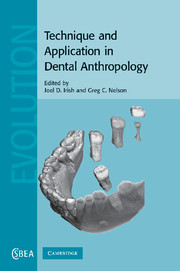Book contents
- Frontmatter
- Contents
- Contributors
- Acknowledgments
- Section I Context
- Section II Applications in assessing population health
- Section III Applied life and population history
- Section IV Forefront of technique
- 15 Methods of ingestion and incisal designs
- 16 Dental reduction in Late Pleistocene and Early Holocene hominids: alternative approaches to assessing tooth size
- 17 Dental microwear analysis: historical perspectives and new approaches
- 18 Virtual dentitions: touching the hidden evidence
- Index
- References
16 - Dental reduction in Late Pleistocene and Early Holocene hominids: alternative approaches to assessing tooth size
Published online by Cambridge University Press: 12 September 2009
- Frontmatter
- Contents
- Contributors
- Acknowledgments
- Section I Context
- Section II Applications in assessing population health
- Section III Applied life and population history
- Section IV Forefront of technique
- 15 Methods of ingestion and incisal designs
- 16 Dental reduction in Late Pleistocene and Early Holocene hominids: alternative approaches to assessing tooth size
- 17 Dental microwear analysis: historical perspectives and new approaches
- 18 Virtual dentitions: touching the hidden evidence
- Index
- References
Summary
Introduction
Contemporary humans have, on average, the smallest teeth of any hominid throughout the evolutionary history of the family. Within the genus Homo, the trend over the past two million years has been one of dental reduction; however, many anthropologists believe that this has been especially marked over the last 100 000 years or so (the Late Pleistocene and Holocene periods), both in Neandertals and so-called anatomically modern Homo sapiens (Brace, 1964, 1967, 2000; Brace et al., 1987; Calcagno, 1989; Calcagno and Gibson, 1991; Carlson and van Gerven, 1977; Frayer, 1978, 1984; y'Edynak, 1989, 1992). The way in which this reduction of tooth size came about is one of the key issues in the evolution of modern humans; yet, in order to understand this process, it is necessary to confront the issue of how tooth size should be assessed. It is clear that with rapidly advancing technology (some examples of which can be found in this volume), it may someday be possible to employ precise volumetric and morphometric methods of tooth assessment that can be easily applied in an “in vivo” field/collection situation. At present, however, it is more practical to use simple caliper measurements.
In this chapter we assess the traditional methods of determining tooth dimensions and discuss an alternative approach adopted for a study of dental reduction in hominids of the Late Pleistocene and Holocene. We then evaluate the effectiveness of the conventional methods vs. our proposed alternative.
- Type
- Chapter
- Information
- Technique and Application in Dental Anthropology , pp. 364 - 388Publisher: Cambridge University PressPrint publication year: 2008
References
- 4
- Cited by

